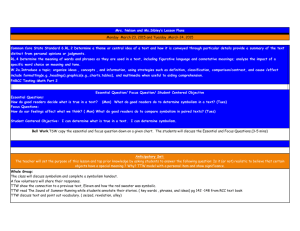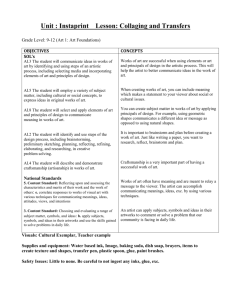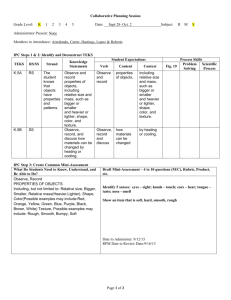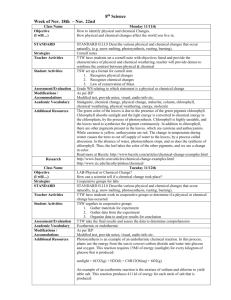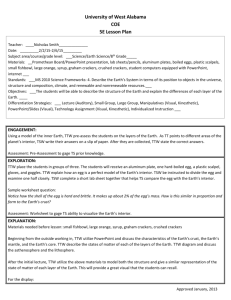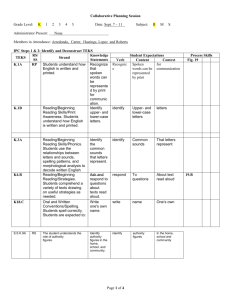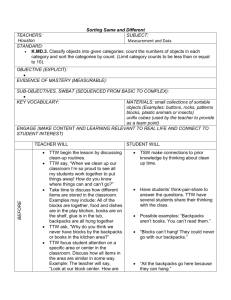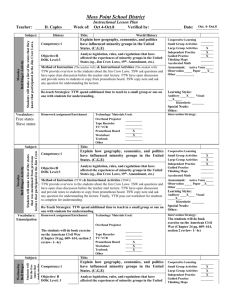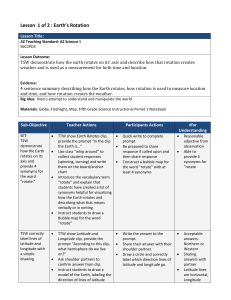Elementary Week Lessons
advertisement
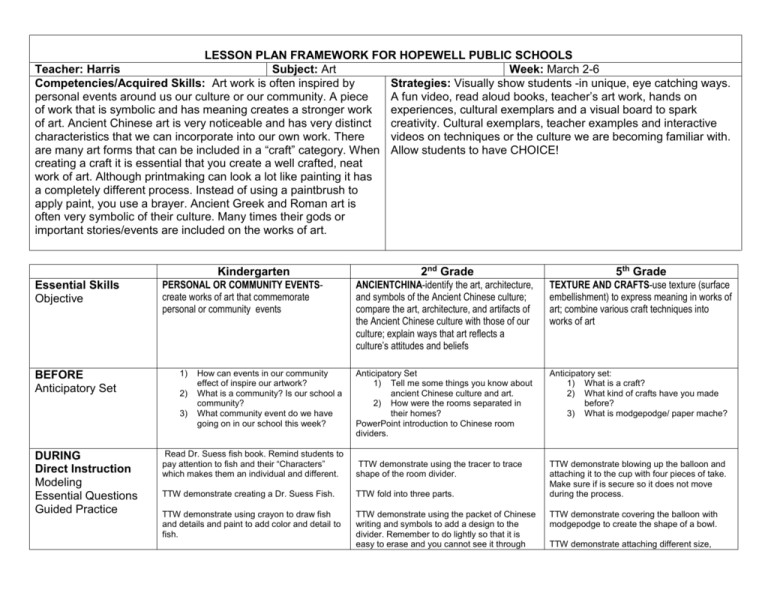
LESSON PLAN FRAMEWORK FOR HOPEWELL PUBLIC SCHOOLS Teacher: Harris Subject: Art Week: March 2-6 Competencies/Acquired Skills: Art work is often inspired by Strategies: Visually show students -in unique, eye catching ways. personal events around us our culture or our community. A piece A fun video, read aloud books, teacher’s art work, hands on of work that is symbolic and has meaning creates a stronger work experiences, cultural exemplars and a visual board to spark of art. Ancient Chinese art is very noticeable and has very distinct creativity. Cultural exemplars, teacher examples and interactive characteristics that we can incorporate into our own work. There videos on techniques or the culture we are becoming familiar with. are many art forms that can be included in a “craft” category. When Allow students to have CHOICE! creating a craft it is essential that you create a well crafted, neat work of art. Although printmaking can look a lot like painting it has a completely different process. Instead of using a paintbrush to apply paint, you use a brayer. Ancient Greek and Roman art is often very symbolic of their culture. Many times their gods or important stories/events are included on the works of art. 2nd Grade 5th Grade ANCIENTCHINA-identify the art, architecture, and symbols of the Ancient Chinese culture; compare the art, architecture, and artifacts of the Ancient Chinese culture with those of our culture; explain ways that art reflects a culture’s attitudes and beliefs TEXTURE AND CRAFTS-use texture (surface embellishment) to express meaning in works of art; combine various craft techniques into works of art Anticipatory Set 1) Tell me some things you know about ancient Chinese culture and art. 2) How were the rooms separated in their homes? PowerPoint introduction to Chinese room dividers. Anticipatory set: 1) What is a craft? 2) What kind of crafts have you made before? 3) What is modgepodge/ paper mache? Read Dr. Suess fish book. Remind students to pay attention to fish and their “Characters” which makes them an individual and different. TTW demonstrate using the tracer to trace shape of the room divider. TTW demonstrate creating a Dr. Suess Fish. TTW fold into three parts. TTW demonstrate blowing up the balloon and attaching it to the cup with four pieces of take. Make sure if is secure so it does not move during the process. TTW demonstrate using crayon to draw fish and details and paint to add color and detail to fish. TTW demonstrate using the packet of Chinese writing and symbols to add a design to the divider. Remember to do lightly so that it is easy to erase and you cannot see it through Kindergarten Essential Skills Objective BEFORE Anticipatory Set PERSONAL OR COMMUNITY EVENTScreate works of art that commemorate personal or community events 1) 2) 3) DURING Direct Instruction Modeling Essential Questions Guided Practice How can events in our community effect of inspire our artwork? What is a community? Is our school a community? What community event do we have going on in our school this week? TTW demonstrate covering the balloon with modgepodge to create the shape of a bowl. TTW demonstrate attaching different size, TTW demonstrate painting a striped background on separate piece of paper for fish. TTW demonstrate cutting the fish and attaching it to the background. AFTER Independent Practice Assessment Closure TSW create a Dr. Suess Fish. TSW use crayon to draw fish and details and paint to add color and detail to fish. TSW paint a striped background on separate piece of paper for fish. TSW cut the fish and attaching it to the background. Assessment: Formative and Summative- TTW walk around the class making sure that all students are on task, using materials appropriately and following instructions. TTW grade works of art based on the student’s demonstration of understanding and ability to follow directions and create an “individual” character fish. Closure: 1) What community event do we have going on in school this week? 2) Can this event influence or spark ideas for our artwork? the watercolor. TTW demonstrate LIGHTLY painting a background color and then painting the designs. Traditionally, use black on symbols and a subtle touch of color for flowers and other designs. TTW demonstrate splatter painting for an extra detail. TSW use the tracer to trace shape of the room divider. shape and color of tissue paper to the balloon. It will stick with the modgepodge. TTW demonstrate adding other items like confetti or buttons to add texture and visual interest to the bowl. TSW blow up the balloon and attaching it to the cup with four pieces of take. Make sure if is secure so it does not move during the process. TSW fold into three parts. TSW use the packet of Chinese writing and symbols to add a design to the divider. Remember to do lightly so that it is easy to erase and you cannot see it through the watercolor. TSW LIGHTLY paint a background color and then painting the designs. Traditionally, use black on symbols and a subtle touch of color for flowers and other designs. TSW splatter paint for an extra detail. Assessment: Formative and Summative- TTW walk around the class making sure that all students are on task, using materials appropriately and following instructions. TTW grade works of art based on the student’s demonstration of understanding and ability of create a well designed room divider. Closure: 1) How did the Chinese separate the rooms in their homes? 2) What did they paint on the room dividers? 3) Were they bright and bold? TSW cover the balloon with modgepodge to create the shape of a bowl. TSW attach different size, shape and color of tissue paper to the balloon. It will stick with the modgepodge. TSW add other items like confetti or buttons to add texture and visual interest to the bowl. Assessment: Formative and Summative- TTW walk around the class making sure that all students are on task, using materials appropriately and following instructions. TTW grade works of art based on the student’s demonstration of understanding and ability of create a well crafted, sturdy, visually interesting bowl. Closure: 1) What is a craft? 2) How was the tissue paper changed to become sturdy? Resources Technology SOLs Dr. Suess book, paint, crayons, scissors, paint brush, teacher example, glue. Teacher example, Chinese writing/symbols handout, tracers, pencil, watercolor, paint brushes, powerpoint, white large paper Teacher example, glue, sponge paint brush tissue paper, balloon, paper cups, tape K.5 2.11, 2.12, 2.13, 2.21 5.5.3 5.11 Notes Will take two classes to complete. Will take two classes to complete Will wait until dry to remove balloon. LESSON PLAN FRAMEWORK FOR HOPEWELL PUBLIC SCHOOLS Teacher: Harris Subject: Art Week: March 2-6 Competencies/Acquired Skills: Art work is often inspired by Strategies: Visually show students in unique, eye catching ways. personal events around us our culture or our community. A piece A fun video, read aloud books, teacher’s art work, hands on of work that is symbolic and has meaning creates a stronger work experiences, cultural exemplars and a visual board to spark of art. Ancient Chinese art is very noticeable and has very distinct creativity. Cultural exemplars, teacher examples and interactive characteristics that we can incorporate into our own work. There videos on techniques or the culture we are becoming familiar with. are many art forms that can be included in a “craft” category. Allow students to have CHOICE! When creating a craft it is essential that you create a well crafted, neat work of art. Although printmaking can look a lot like painting it has a completely different process. Instead of using a paintbrush to apply paint, you use a brayer. Ancient Greek and Roman art is often very symbolic of their culture. Many times their gods or important stories/events are included on the works of art. 1st Grade 3rd Grade Essential Skills Objective PEOPLE AND OBJECTS IN THE ENVIRONMENT-Identify and use figure-ground relationships in works of art; create observational drawings of people and objects in the environment ANCIENT GREECE AND ANCIENT ROMEexamine the art and architecture of Ancient Greece and Ancient Rome and identify their common attributes; understand that art reflects times, places, and cultures; discuss the form and function of artifacts from these cultures Printmaking- Examine the process of making artworks by printing, normally on paper. Printmaking normally covers only the process of creating prints that have an element of originality, rather than just being a photographic reproduction of a painting. BEFORE Anticipatory Set Bell ringer with eagle tracks Bell ringer with eagle tracks 1) What are some facts you’ve learned about ancient Greece and Rome? 2) Who started the Olympic games? 3) What do you know about their gods? 4) Do you know how all of this affected Bell Ringer with Eagle Tracks 1) Has anyone ever heard of Gyotaku fish prints? 2) How do you think you would go about making a print of a fish? 3) What do you know about Japanese art? 1) 2) When drawing or painting are we allowed to go off the edge of the paper? What are some things that we might draw or paint from our environment? 4th Grade 3) DURING Direct Instruction Modeling Essential Questions Guided Practice What kind of artist was Vincent Van Gogh? their artwork? What color do you most often see in their pottery? 6) What purpose does their pottery serve? PowerPoint on Greek/ Roman pottery PowerPoint on Gyotaku fish prints, process, meaning, culture and Japanese Art TTW demonstrate drawing objects (a vase of flowers) something commonly seen in our environment. TTW demonstrate using the packet to choose a Greek vase shape and draw it on the paper using pencil. TTW demonstrate using a brayer to ink up the rubber fish. TTW demonstrate drawing the object close up going off the page! Put paper under students work so that they’ll feel comfortable drawing off the paper. TTW demonstrate using the packet of commonly seen Greek/ Roman line design and the student will draw it on their vase. TTW demonstrate painting using dots instead of the typical way of painting. TTW demonstrate using bright, vivid colors like Van Gogh would have in his own work. 5) TTW demonstrate adding a story to some part of the vase like the Greek/ Romans would have done. TTW demonstrate going over pencil line with copper colored paint. Leaving NO PENCIL LINES! TTW demonstrate how to apply paint using a brayer as apposed to a paintbrush. This is for students to become familiar with the process of printmaking. TTW demonstrate rubbing the fish to create a monotype print in a similar fashion that the Japanese would make a Gyotaku print. TTW demonstrate using the packet of Japanese symbols to add a small symbol in one of the corners similar to how the Japanese would have added small information to their work. TTW demonstrate cutting out the vase for the final step. AFTER Independen t Practice Assessment Closure TSW draw objects (a vase of flowers) something commonly seen in our environment. TSW use the packet to choose a Greek vase shape and draw it on the paper using pencil. TSW draw the object close up going off the page! Put paper under students work so that they’ll feel comfortable drawing off the paper. TSW use the packet of commonly seen Greek/ Roman line design and the student will draw it on their vase. TSW paint using dots instead of the typical way of painting. TSW add a story to some part of the vase like the Greek/ Romans would have done. TSW use bright, vivid colors like Van Gogh would have in his own work. Closure: TSW go over pencil line with copper colored paint. TSW cut out the vase for the final step. Assessment: Formative and Summative- TTW walk around the class making sure that all students are on task, using materials appropriately and following instructions. TTW grade works of art based on the student’s demonstration of understanding and ability to follow directions and paint/ draw realistically going OFF the paper. ZOOM IN! Closure: 1) Who is Van Gogh? 2) What kind of colors did he use in his Assessment: Formative and Summative- TTW walk around the class making sure that all students are on task, using materials appropriately and following instructions. TTW grade works of art based on the student’s demonstration of understanding and ability to follow directions and created a well crafted Greek/Roman vase. TSW use a brayer to ink up the rubber fish. TSW apply paint using a brayer as apposed to a paintbrush. This is for students to become familiar with the process of printmaking. TSW rub the fish to create a monotype print in a similar fashion that the Japanese would make a Gyotaku print. TSW use the packet of Japanese symbols to add a small symbol in one of the corners similar to how the Japanese would have added small information to their work. Closure: 1) Who made Gyataku prints? 2) Did they use real fish? 3) What else did they add to the work beside the print? 4) What is printmaking and with what do you apply paint with in printmaking? Assessment: Formative and Summative- TTW walk around the class making sure that all students are on task, using materials appropriately and following instructions. TTW grade works of art based on the student’s demonstration of understanding and ability to work? Is it okay to go off the paper and zoom in on what you’re painting/ drawing? Paper, paint, Van Gogh book, teacher example, paintbrushes, newspaper, pencils. follow directions and created a Monoprint and add symbols. 3) Resources Technolog y SOLs Notes Teacher example, black paper, Greek line design and vase shape packets, copper paint, pencil, scissors. Rubber fish, brayer, paper, printmaking paint, Japanese symbols packet, teacher example, PowerPoint. 1.9, 1.11 3.11, 3.13, 3.14, 3.15, 3.16 4.11, 4.12, 4.14 Will take two classes to complete. Will take two classes to complete Will take two classes to complete. Hopewell City Public Schools Lesson Plan WIDA Standards Addendum K-12 Page 1 Teacher: Harris Course/Grade: Art WIDA Standards: X Standard 1: English language learners communicate for Social and Instructional purposes within the school setting. Standard 2: English language learners communicate information, ideas and concepts necessary for academic success in the content area of Language Arts. Standard 3: English language learners communicate information, ideas and concepts necessary for academic success in the content area of Mathematics. Standard 4: English language learners communicate information, ideas and concepts necessary for academic success in the content area of Science. Standard 5: English language learners communicate information, ideas and concepts necessary for academic success in the content area of Social Studies. English Language Proficiency: X Level 1 X Level 2 X Level 3 X Level 4 X Level 5 X Level 6 Possible Recommendations to Address Instructional Methods, Learning Needs, and English Acquisition for Content Areas of Science, and Math (check all that apply) scaffold responses ry materials Language Arts, Social Studies, brainstorms sheltered instruction restraints X paraphrase directions for tasks sations written responses administer assessments in small groups use visual cues daily use graphic organizers X pair with a peer tutor break tasks/ directions into sub tasks X read aloud for language modeling X speak slowly and face student when speaking increase wait time content area X label items in a classroom assessments ______________________________________ ____
